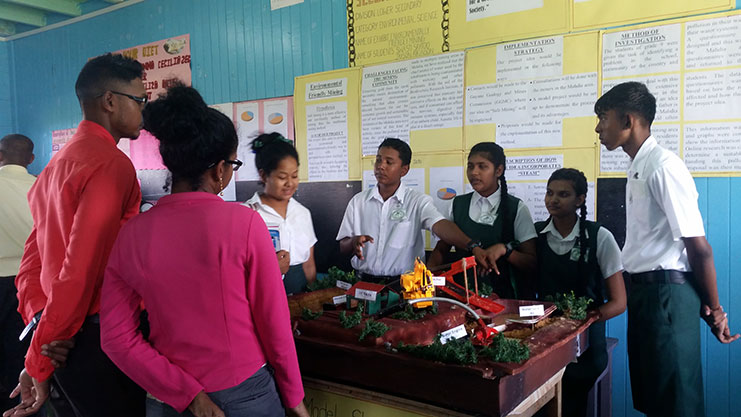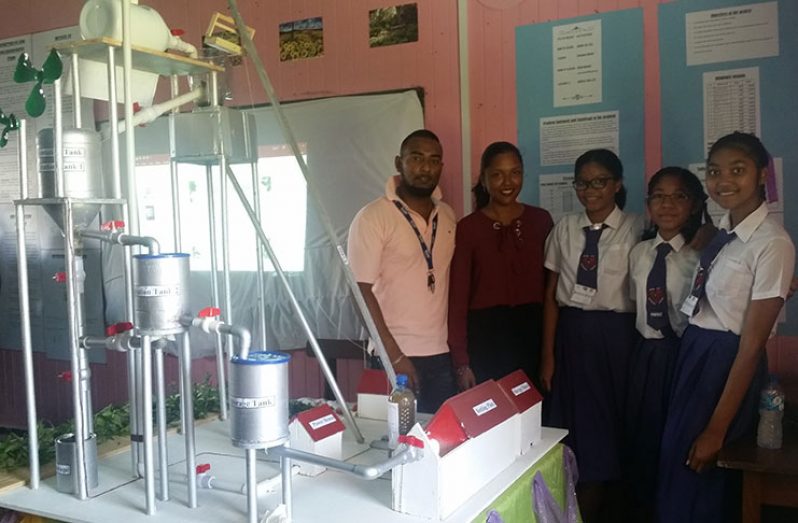–as annual STEM fair goes to Region 2
By Indrawattie Natram
INNOVATION was the order of the day on Thursday as Secondary School students across Region Two (Pomeroon-Supenaam) proved their prowess at Science, Technology, Engineering, the Arts and Mathematics.
The occasion was the annual STEM fair, which this year is being held under the sub- theme, “Paving the way for a green and sustainable society”.
The event was declared open on Wednesday by Region Two Chairman, Devanand Ramdatt at the Cotton Field Secondary School, and saw participation from 29 schools.
But what generated much interest was the way teachers and students did their research to assist in paving the way for a green and sustainable society.

Scores of students flocked the various projects, and were visibly blown away by the innovation they saw on display.
Grabbing a lot of attention was the Abram Zuil Secondary’s Neem, Garlic and Pepper (NGP) project, the main objectives of which was to minimise pest infestation; reduce air, land and water pollution; reduce mutation of the genes which lead to the production of cancer cells; and create employment and reduce poverty.
According to the students, even though chemicals can do the same job where eradicating the problem of infestation is concerned, they can cause serious health hazards.
As such, the students and teachers came up with the novel idea of utilising organic materials to manufacture an inorganic pesticide that is environmentally-friendly, by using neem, garlic and pepper. Another plus on the concoction’s side is that it will not only help the farmer obtain an inexpensive pesticide, but also have a better yield.

Over at the Charity Secondary School’s booth, Ashana Gonsalves explained that the objective of their project was to demonstrate the advantages of aquaponics, one of which is to produce organic food in a healthy and sustainable environment.
The objective of the students’ research was to investigate whether the use of solar energy and aquaponics farming in schools can pave way for a “green” and sustainable agricultural sector.
Their project was to promote the symbiosis between plants and animals to produce organic food through the use of solar energy.
The Aurora Secondary, under the Information Technology category, displayed an immersive playground, while students and teachers from the Anna Regina Multilateral Secondary School (ARMS) came up with a novel idea of helping the Guyana Geology and Mines Commission (GGMC) improve the mining sector.
Their project demonstrated ways of saving the environment by employing what is called “safe mining” practices.
The idea behind it is that extracting gold from the earth inevitably means the destruction of the natural environment, something that often runs counter to economic growth and sustainable use of the country’s natural resources.
During mining activities in Madhia, residents are often affected by a high level of pollution in their waterways and their water system.
The students reportedly conducted a survey in the Mahdia area, where it was revealed that residents there are severely affected by pollution.
Online researches were also done to determine a suitable way of handling the pollution.
The proposal was then made to have two pits instead of one so that the waste water (tailings) can be recycled. Mining can also be done in the extra pit, which would also be an advantage to small-scale miners.
Meanwhile, Wakapoa Secondary in the Lower Pomeroon came up with the idea of making a Marine Cleaner in an effort to deal with pollution.
The students said that the Pomeroon and other riverine areas have been polluted due to improper garbage disposal, which affects the environment.
The objective of their project was to ensure that floating debris in the waterways are cleared. The cleaner is powered by a clean and renewable source of energy, thereby contributing to a greener society.



.jpg)










